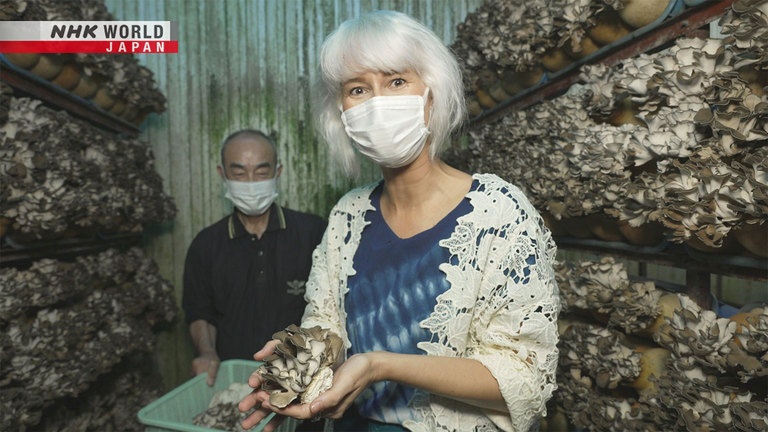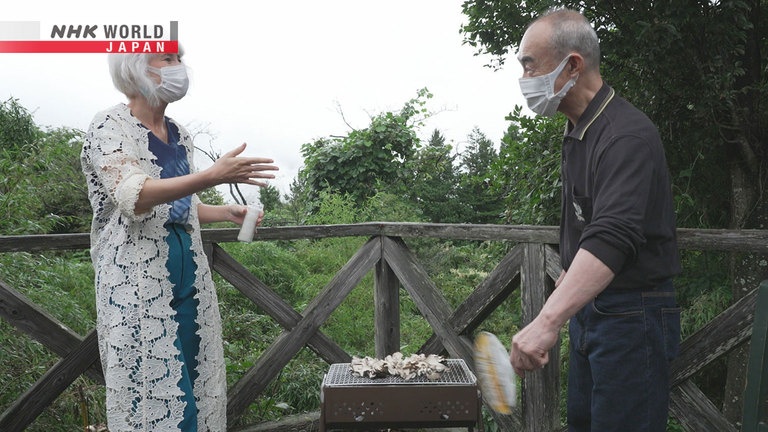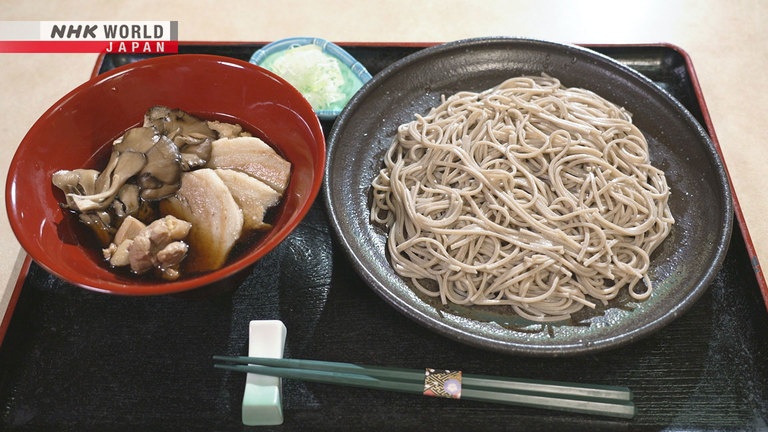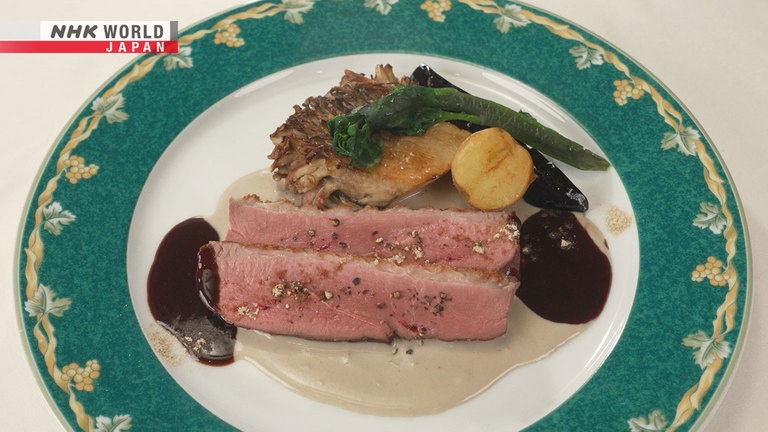MAITAKE
Maitake are popular mushrooms packed with aroma and umami. Their uniquely firm texture is perfect for tempura and stir-fried dishes. The development of cultivation technology has taken the once elusive variety from the depths of the wild to local shops, all year round and at affordable prices. Visit a mountain farm outside Tokyo to see how they're grown using natural spring water, then feed your appetite at a French restaurant specializing in mushroom dishes. (Reporter: Saskia Thoelen)




Transcript
Tokyo: this world-class metropolis is a veritable gourmet wonderland.
Discover the stories behind the ingredients that make this city so delicious - "so oishii."
Mushrooms are a taste of fall.
And Japan is one of the biggest consumers.
A top favorite is a type called "maitake."
"Mai" means dance, and "take" means mushroom.
And those who stumble across them in the wild would surely jump with joy!
Its aroma and flavor are like no other!
"Oishii."
Their distinct flavor and texture are perfect for Japanese dishes like "nabe" hot pots, tempura, and rice recipes.
Maitake have been consumed in Japan for thousands of years.
The elusive mushrooms grow deep in the wild, so in the past, they were quite a luxury.
Advanced farming technology has made them available all year round.
We'll harvest these today.
They look like flowers!
Dig in to find out why Japan is so head-over-heals for this funny-looking mushroom.
Trails to Oishii Tokyo.
Hi, I'm Saskia from Belgium. And today's theme is maitake.
So, in Japan, all different types of mushrooms are eaten.
And in Belgium I've been eating mushrooms regularly too.
But it's only since I came to Japan that I discovered maitake, and I absolutely love it.
So, maitake are also called the illusionary mushroom and I'm about to find out what the meaning is of that expression.
So let's have a look!
Saskia begins in Toyosu, at one of the world's largest wholesale markets.
Naturally, it's a hub for fruits and veggies from all over the country.
She appears to have found someone to interrogate.
President Kajiyama Toshiharu is a certified vegetable sommelier.
- Do you have maitake?
- Yes. We have a lot.
These are maitake.
Here and here.
Many varieties.
- They look like flowers.
- Right. The tops look like fans.
These are cut for household use.
- These are dark, but we have white too.
- Also maitake?
- This type is unique to Japan.
- Really?
Interesting.
Grown naturally or farmed?
These were all farmed.
Natural ones are rare.
Pickers don't even tell family where
they find them. They're that rare.
- Really?
- Yes.
- Like finding treasure.
- Exactly.
Maitake grow at the base of broadleaf trees in temperate climates all around the world, but are very difficult to come by.
Maitake grow in other countries, but
I think Japan is the largest consumer.
- They're not eaten as much overseas.
- I see.
Maitake are popular here because
technology has made them more available.
But we love mushrooms in general,
not just maitake.
Maitake are quite fickle, so they were difficult to cultivate until technology improved in the 1970s.
Maitake production surged as more large-scale facilities popped up.
Now, they're grown in monitored environments all across the country.
What's the difference between
natural and farmed?
Natural ones are thicker with an earthier aroma.
But technology has narrowed the gap a lot.
This closely resembles wild maitake.
It's big.
In nature, this grows at the base of a tree.
Nice, strong aroma.
That's maitake.
Aroma is the key feature.
A type called "matsutake" is considered
the king of mushrooms in Japan.
Maitake have a softer aroma.
I guess you could say they're the queen.
The queen of mushrooms!
Now I have to see how they're cooked.
I can't wait to try some!
Saskia visits a renowned restaurant in Nishi-azabu, a gourmet district in Tokyo.
A 40-year veteran, Nishizuka Shigemitsu has a knack for highlighting ingredient flavors, and immaculate presentation.
The first dish.
- Looks lovely.
- Enjoy.
A colorful fall dish.
Maitake are seasoned with sake and salt, and grilled.
This is mixed with salmon roe and garland chrysanthemum, another fall ingredient.
Thin omelet slices go on top.
"Oishii."
They're slightly sweet.
Sweetness, or "umami."
It's a dense flavor.
A unique texture as well.
They have more crunch than
other types of mushrooms.
I guess so.
We eat white mushrooms in Belgium.
They have a subtle flavor, so they often
play a more supportive role in dishes.
- Maitake can play the leading role.
- Right.
They're better for making broth too.
Maitake are quite high in guanylic acid - a flavor enhancer.
It offers intense umami, especially when served in "kombu" or "katsubuoshi" broth.
Here, maitake are stewed with "wagyu" beef, green onions, and "mizuna" - a mustard green.
Lovely smell.
Looks so good.
- Different from the previous dish.
- This really brings out the umami.
Fantastic.
Last but not least, maitake rice.
Rice is cooked in a soy sauce broth with maitake and gingko nuts, yet another fall ingredient.
The earthy flavor of the maitake
goes well with the gingko nuts.
But it doesn't overpower the rice flavor.
Maitake have distinct aroma and texture,
but work well with other ingredients.
They enhance the dish overall.
What makes maitake special?
In Japan, we used to look forward to
eating them in the fall.
Advanced technology improved flavor
and made them available all year round.
They're no longer a fall delicacy,
but are a special ingredient overall.
They add new life to recipes.
Next, Saskia heads to a mountain village called Hinohara, about 50 kilometers west of central Tokyo.
She'll meet a maitake farmer who's truly one with the natural surroundings, some 1,000 meters above sea level.
I can't believe we're still in Tokyo.
We're getting deeper and deeper into the mountains, there's forests everywhere.
I can't believe that this is also Tokyo. Completely different image.
We keep climbing.
This is pretty high up.
We're in the middle of nowhere!
I see buildings. Are we here?
This maitake plant sits at an altitude of 850 meters.
Hinohara-native Nakamura Chikara has been operating here for 27 years.
Why grow maitake high up in the mountains?
Maitake grow naturally at an altitude
of around 1,000 meters.
Farming maitake at a high altitude with natural water
is as close as it gets to the real thing.
The maitake he grows are thick, chewy, and full of flavor.
On a busy day, they ship as much as 100 kilograms.
Nakamura will take Saskia through the process.
This room is kept at 26 degrees Celsius and 70 percent humidity.
Warmer than outside.
It is. This is the fungus room.
It sits here for about 25 days.
We collect maitake fungus and
store it here to let it develop.
The mushrooms grow from a mycelium, a network of fungus, which is planted in a culture medium.
The culture media used for maitake mainly contain sawdust from hardwood trees.
The mixture is housed in a plastic container.
Maitake fungus is added after the sawdust is sterilized to prevent mold.
This is how it starts.
I put fungus in yesterday.
- It's still just sitting at the top.
- I see.
I'll show you one that's a week old.
The fungus has spread.
The white color means the fungus is growing.
This is after sitting for 25 days.
Faster ones will look like this.
Amazing.
Looks like marshmallows!
Very interesting.
This room offers a summer climate.
The fungus grows, then it's moved
to rooms with cooler, fall climates.
Then, buds begin to sprout.
You recreate months of the season.
This is the growth room.
It's set to a September climate of 21 degrees Celsius.
Humidity is set to 90%.
This room recreates the area's September climate.
The cooler temperature allows
the mushrooms to grow.
Oh, I see.
It's taking on a different color and shape.
Mushrooms grow as they take in
nutrients from the sawdust.
Interesting.
They spend a week here,
then they go to the final room.
The final stage takes place in what's dubbed the "October room."
It's cooler in here.
It's humid in here too,
but about 20 degrees Celsius.
- These are harvest-ready maitake.
- Finished?
They look like flowers.
Wow!
- It's been 10 days.
- Only?
Right.
That's fast. They grow quickly.
Especially in the final two days.
Really?
100% humidity.
Water from a local stream is sprayed every few minutes to foster growth.
We use mountain stream water
so moss and algae can grow inside too.
In nature, maitake grow around moss and algae.
This allows our maitake to
taste closer to natural ones.
It makes sense to mirror nature
in a controlled setting.
This is really interesting.
Being surrounded by nature presented a lot of obstacles.
It took a long time to achieve stable production.
Starting out, it was wiped out
by mold several times.
Beyond that, I didn't know enough about
the key features of the local environment.
Maitake are quite tricky.
Many things keep them from growing.
But this didn't stop him.
After years of trial and error, he discovered what it takes to make tasty maitake.
We finally reached stable production
about 10 years ago.
Another day of victory - time to harvest!
- Oh, I see.
- It'll come.
Got it.
A strong mushroom smell.
Yes, an earthy smell.
The smell of a fresh harvest.
I love it.
Hinohara maitake are now a local specialty.
They're shipped to high-end department stores and Japanese restaurants in Tokyo and beyond.
They even make popular gifts!
Time to cook up some fresh maitake!
Grill them over charcoal, and add a dash of salt.
-Nice.
- Smells great, right?
It does!
Smells great. Rich aroma.
It's so nice. So, you have this slight, slight salt flavor together with the maitake flavor, and it really brings it out.
It's very, very earthy, very warm, really good.
And then you have the texture - a nice chew to it.
So good.
- Crisp and tasty.
- It really is.
"Oishii."
The water and atmosphere of the mountains are key ingredients in Hinohara's tasty maitake.
Saskia heads to a restaurant in Hachioji, near Hinohara.
They're a proud customer of Nakamura's mushrooms.
Soba noodles are served with a dipping sauce containing chicken, pork, and - you guessed it - maitake.
- A full maitake flavor!
- You can taste it?
Everything soaked up the maitake flavor.
Maitake from Hinohara not only
taste good, but have great aroma too.
Now for some crispy maitake tempura.
Tempura is a common soba side dish.
It's like bread and butter.
Strong umami.
The mushrooms are nice and crispy.
This is maitake "tsukudani."
Mushrooms are stewed for five hours in soy sauce, sugar and sake.
They retain their shape.
Right. They don't break apart.
- That makes it good for tsukudani.
- Right, it's a good ingredient for it.
"Itadakimasu."
- It's pretty salty.
- It is.
"Oishii."
Tsukudani is a traditional preserved food.
It's long been a vital source of nutrition during harsh winters.
Another example of how nature has played a leading role in Japan's food culture.
Back in the metropolis, Saskia will meet a true maitake believer.
Yamaoka Shoji has been a chef for 43 years.
He fell in love with mushrooms while training at a starred restaurant in France.
He decided to focus on the ingredient after returning to Japan.
He has something special in store for Saskia today.
Thanks for waiting.
Here's the first dish.
Wow. Beautiful.
His original recipe - maitake dipped in batter containing buckwheat seeds and chopped "sakura ebi" shrimp, deep-fried for about two minutes.
The sauce is chicken stock with milk and red pepper puree.
"Itadakimasu."
Excellent.
Maitake is great on its own.
It doesn't take much.
I taste the shrimp first, then there's
the crunchy texture of the buckwheat seeds.
The maitake comes out the more you chew.
It has great presence.
It takes on a leading role when
mixed with other ingredients.
I'm glad I can use maitake all year round.
Farmed ones, or natural ones in season.
We can enjoy both. I see the maitake
as Japan's representative mushroom.
The next dish features a variety with thicker stems.
Maitake and duck breast are seared in a pan, then cooked in the oven.
The mushrooms absorb the rich, fatty juices of the meat.
Seasonal veggies add a pop of color.
- I'll start with the maitake.
- Sounds good.
It's soft.
Very fresh and juicy.
Good?
I sure think so.
Fantastic!
- Roasted maitake is very satisfying.
- It really hits the spot.
I cook it with the duck to enhance
the overall flavor experience.
The butter makes it sweet, and the earthy
maitake flavor expands in your mouth.
- No butter in this, though.
- What?
No butter. That's duck fat.
- The maitake soaks it up, and that produces a sweet flavor.
- I see.
Even the sauce is made of maitake.
I stewed dried maitake to make the sauce.
- It's packed with maitake flavor.
- Right.
Drying the maitake condenses
flavor and nutritional content.
So, it makes a great umami-packed sauce.
Maitake's rich umami lifts up any ingredient it's paired with.
This dish puts maitake front-and-center, highlighting its excellent flavor.
What's special about maitake to you?
I love everything about it.
There's nothing quite like it.
And I want the whole world to know
how amazing it is.
It's a food we can all be proud of.
Maitake - the elusive mushroom that grows deep in the forests was once largely out of reach.
Technology was improved so that it could be more available on the market - it tastes that good!
Now, maitake is cherished everywhere in Japan, all year round.
But it doesn't have to stop there.
Maitake will soon take the world by storm.
In Tokyo, every ingredient has its own story.